DRIVING THIS STRETCH OF SHEPHERD WILL NEVER BE THE SAME 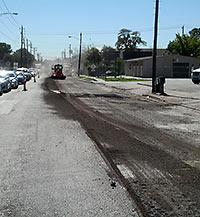 Not for a couple more shrink-swell cycles, at least. A reader heralds the coming cataclysm: “Shepherd between Memorial and I-10 has begun to experience a transfiguration ranking with the most sublime heavenly experiences in the history of mankind: Milling trucks have been scraping the ragged, churned old asphalt in preparation for a new road, a new land, a new Jerusalem! Yes — fresh, smooth, new pavement on Shepherd Drive! Hallelujah!” Photo: Rachel Dvoretzky
Not for a couple more shrink-swell cycles, at least. A reader heralds the coming cataclysm: “Shepherd between Memorial and I-10 has begun to experience a transfiguration ranking with the most sublime heavenly experiences in the history of mankind: Milling trucks have been scraping the ragged, churned old asphalt in preparation for a new road, a new land, a new Jerusalem! Yes — fresh, smooth, new pavement on Shepherd Drive! Hallelujah!” Photo: Rachel Dvoretzky
Streets
COMMENT OF THE DAY: NAMING THE HEIGHTS’ GREAT STUDEWOOD “The 1200 block of Omar isn’t in Norhill; it’s west of the Studivide.” [mollusk, commenting on Daily Demolition Report: A Crush on Omar]
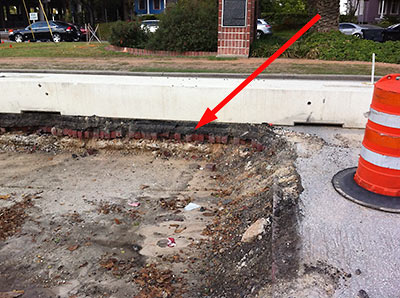
From his Twitter command post, Swamplot reader Greg Arnold sends these photos of what Heights-area I-10 feeder road construction has unearthed: Actual bricks under Heights Blvd.’s longtime (and future) surface of asphalt.
SOMEBODY FORGED TURTLEWOOD SQUARE SIGNATURES, BUT IT WASN’T HOANG 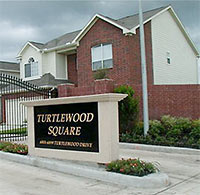 Who forged neighbor signatures on a petition circulated to change the name of Turtlewood Dr. to Little Saigon Dr.? Someone who submitted them to city council member Al Hoang, a preliminary inquiry by the city’s Office of the Investigator General has determined. The report, issued last week, also appears to clear Hoang of allegations that he abused city resources in seeking to get the name of his street — in a development called Turtlewood Square, south of Bellaire Blvd. just outside the Beltway — switched. A lawsuit filed by neighbors in the case will continue; the decision on whether to proceed with an investigation of the forgeries will be up to the district attorney’s office. [Houston Politics; more detail; previously on Swamplot] Photo: HAR
Who forged neighbor signatures on a petition circulated to change the name of Turtlewood Dr. to Little Saigon Dr.? Someone who submitted them to city council member Al Hoang, a preliminary inquiry by the city’s Office of the Investigator General has determined. The report, issued last week, also appears to clear Hoang of allegations that he abused city resources in seeking to get the name of his street — in a development called Turtlewood Square, south of Bellaire Blvd. just outside the Beltway — switched. A lawsuit filed by neighbors in the case will continue; the decision on whether to proceed with an investigation of the forgeries will be up to the district attorney’s office. [Houston Politics; more detail; previously on Swamplot] Photo: HAR
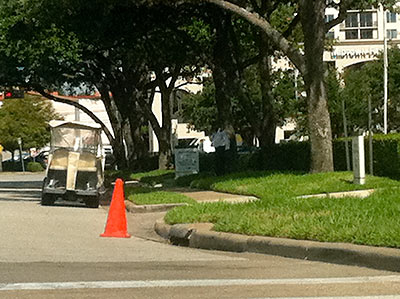
 As of Friday evening, new we’re-gonna-tow-you-if-you-park-here signs have been installed along D’Amico St. just north of the new Waugh Dr. Whole Foods Market, reports the Swamplot correspondent who’s been monitoring the parking situation there — and taking in the scene at the new store: “I think the traffic and mass crowds might be worth it,” was the first conclusion, even before the clampdown. These photos, showing the new signs and an American General security detail along D’Amico just west of the office complex parking garage, were taken on a later visit Saturday morning after a follow-up shopping expedition — where our correspondent happily scored 50 bucks’ worth of soda and candy.
As of Friday evening, new we’re-gonna-tow-you-if-you-park-here signs have been installed along D’Amico St. just north of the new Waugh Dr. Whole Foods Market, reports the Swamplot correspondent who’s been monitoring the parking situation there — and taking in the scene at the new store: “I think the traffic and mass crowds might be worth it,” was the first conclusion, even before the clampdown. These photos, showing the new signs and an American General security detail along D’Amico just west of the office complex parking garage, were taken on a later visit Saturday morning after a follow-up shopping expedition — where our correspondent happily scored 50 bucks’ worth of soda and candy.
- Previously on Swamplot: Later on Opening Day: Whole Foods Montrose Afternoon Parking Report
Photos: Swamplot inbox
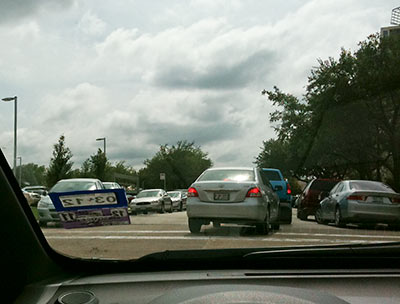
“I don’t know about the Whole Foods parking lot,” writes a Swamplot reader, “but it’s certainly getting real on D’Amico!” Here’s a photo sent in with that report, taken just past the American General Center garage north of the new store on D’Amico St., shortly after 4 pm. But there was plenty of neighborhood-street spillover earlier, too: “Around lunch time, if there was a curb there was a car . . . on both sides along D’Amico, bumper to bumper from the light to just under the garage.” How long will this sort of thing keep up? Our tipster imagines AIG American General will soon put out no-parking signs “along any parts of the street that is their property, such as along the entrance to a parking lot across from whole foods and by the garage. Other areas on the campus have no parking signs where people tend to stop. I know you can’t park within a certain distance to a stop sign, does the same apply to stop lights? If so, some people risked a ticket just to get some groceries! It would be cheaper to pay for parking in the AIG lot or the garage visitor parking.” And no rush, folks. Those free chicken breast coupons are good until next Tuesday.
- Previously on Swamplot: Opening Day: It’s Getting Real Crowded at the Montrose Whole Foods Parking Lot, Beer, Wine, Art, and BBQ on Tap: Here’s Your New Whole Foods Market, Montrose, This Kind of Whole Foods Thing, Getting Real on Waugh at West Dallas This Weekend,
Photo: Swamplot inbox
THE NANNY DIDN’T DO IT In a statement released last Friday, council member Al Hoang clarifies statements he made earlier to the Chronicle and KHOU 11 News’s Jeremy Rogalski that appeared to place blame for the forging of 16 neighbors’ signatures on a nanny no longer employed by Hoang’s family. The signatures were gathered for a petition requesting the name of Hoang’s street be changed from Turtlewood Dr. to Little Saigon Dr. “I have never placed blame on my former personal assistant, as some stories have portrayed,†the statement reads. “I have clearly said that the homeowners association tendered the petition to my assistant at home, not that she maliciously forged that petition.†Hoang says he welcomes the Office of Inspector General investigation into the incident, which Mayor Parker announced last week. [Houston Politics; previously on Swamplot]
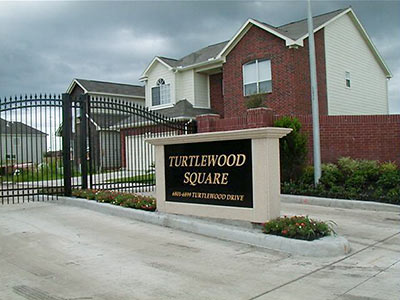
Update, 6/20: Hoang has issued a statement about his nanny.
Mayor Parker has requested a separate city investigation into whether council member Al Hoang forged the signatures of 16 neighbors in a bid to change the name of his street from Turtlewood Dr. to Little Saigon Dr. A petition requesting the name change was circulated among the residents of Turtlewood Square — a development of 47 nine-or-so-year-old homes located behind a Bellaire Blvd. strip center just west of Arthur Storey Park. A lawsuit filed by several residents of the development alleges that the when the petition was given to Hoang it didn’t have the signatures of the required 75 percent of residents. The lawsuit claims that by the time Hoang submitted the petition to the city, it had gained an additional 16 names — all forged. Hoang appears to have told 11 News reporter Jeremy Rogalski that he believes his nanny — who no longer works for him — was responsible for the extra names. After the allegations of forgery, Hoang submitted a direct request for the name change to the city’s planning department. The mayor has put both name change requests on hold pending resolution of the investigation.
- Mayor calls for OIG investigation into Council Member Hoang and City council member accused of forging names to get his way [KHOU 11 News]
Photo: HAR

In 2007, Houston’s city council sold a block of Bolsover St. in the Rice Village to the developers of Randall Davis’s Sonoma project so that it could be used as a private drive and restaurant plaza linking two phases of the development. Davis and Lamesa Properties did manage to demolish the neighboring buildings, but Sonoma was never built. Now, the Hanover Company is saying it’s ready to build portions of a 6-story mixed-use building directly on top of part of that street. Plans for the new project, called Hanover at Rice Village, show a large plaza with restaurant seating on the eastern portion of what used to be Bolsover, facing Morningside. But the west half of the block is slated for retail space, apartments, and a private courtyard for residents:
LOOKING FOR HOUSTON ZERO “In Chicago, there is a ‘zero-point’ at State and Madison, where all addresses move from zero away from that intersection. It seems that Houston has some semblance of this system, as addresses go lower the closer to Buffalo Bayou (on N/S streets at least) and as they cross the bayou, even-numbers go from the west side to the east side. My question is, where is Houston’s null address point? Allen’s Landing? Is it a single point that then radiates due East/West and North/South, or does it follow the bayou? Maybe someone could write a Google map script that plots all the addresses in Houston under the number 100. . . . ” [Swamplot inbox]

Mike Morris hitches a ride on the city’s $500,000 Street Surface Assessment Vehicle, a modified van that’s been hard at work studying street bumps and cracks since last May. Operators hope to complete a pass on more than 16,000 miles of Houston streets by this coming June.
Inside the van, [Patrick] Johnson uses a modified PlayStation controller and a black box with 16 white buttons to run the system, from recording the type of pavement being scanned — cement or asphalt — to marking potholes.
The van’s front lasers, mounted where the bumper used to be, evaluate the pavement surface for rough patches. A second laser device, the “crackscope,” is mounted at the back of the van, recording a continuous bird’s-eye photograph of the street to reveal fissures in the pavement.
A round, 11-lens camera — looking not unlike a disco ball — sits atop the van, recording nearby street features, including culverts and fire hydrants.
Each street starts with a score of 100, but as the lasers find rough patches or cracks and Johnson records each pothole, the score drops.
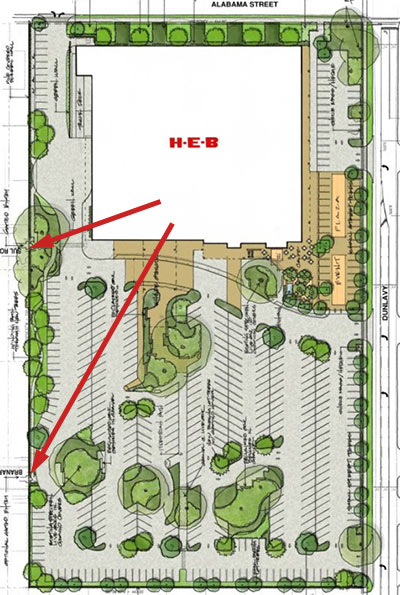
H-E-B agreed several months ago to wall off the ends of Sul Ross and Branard streets, which dead-end into the site of its future Montrose market at West Alabama and Dunlavy, and which served as entrances for the Wilshire Village Apartments that were torn down there last year. But what about devotees of that obscure local Montrose pastime known as walking to the supermarket? If they’re coming from the neighborhoods to the west, should they be able to get through that way?
Over the weekend, the Lancaster Place Civic Association worked out a “compromise” between homeowners on the dead-end portions of Sul Ross and Branard — mostly opposed to having pedestrian gates at the ends of their streets — and homeowners and renters in that neighborhood to the south and southwest of the site, most of whom wanted them included. H-E-B Houston prez Scott McClelland says he’ll have H-E-B’s in-house architects design what the association came up with: A pedestrian gate on Branard, with a timer that will lock it after dark. Sul Ross, which is closer to the store entrance, won’t have a gate, but will have a panel in the wall that would make it easier to put one in later.

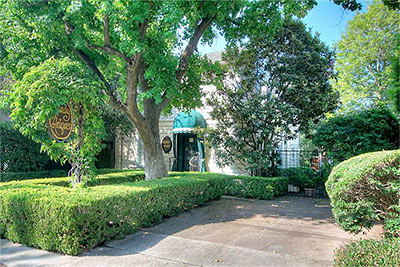
Longtime Ferndale resident Carol Barden (yes, that Carol Barden) clues us into the recent appearance on MLS — at $549K apiece — of 2 out of the 3 wood-frame residences that now make up Jas Gurney Antiques. “It’s such a great little street,” she writes. “All the neighbors are so afraid that some awful developer will demo the houses and build junk. Jas has maintained gardens, old-growth trees, he plants flowers for every season.” Gurney reportedly would prefer to sell his entire inventory of “museum-quality” antiques along with his houses, but hasn’t been able to find a buyer. Also on that mixed-residential stretch of Ferndale, between Westheimer and Alabama: townhouses, plain ol’ houses, 4 more antique stores, Jill Brown’s lighting store, plus several more businesses.
THE PROP. 1 DITCH INCENTIVE If Houston voters pass Proposition 1 in November, the average homeowner will pay about $5 a month to the city’s new drainage and street-renewal fund, Mayor Parker announced today. Commercial properties and homes on curb-and-gutter streets would be assessed 3.2 cents per sq. ft. of hardscape (including building footprints, driveways, porches and parking lots) per year. But owners who live on streets with open ditches would only have to pay at a 2.6-cents-per-sq.-ft. rate. That’d save the average ditch-side homeowner a whopping $11.40 a year. The assessment rate would be fixed for 10 years, and require a two-thirds vote from city council to be raised after that. Reporter Miya Shay has the calculations. [abc13; previously on Swamplot]
WEST END WALMART DEVELOPMENT GETS ITS KOEHLER ST. JOG Despite the protests of a number of speakers — including council member Ed Gonzalez — who wanted some study of neighborhood traffic to be conducted first, the planning commission yesterday approved a minor variance connected with the West End Walmart yesterday, after 2 earlier postponements. The variance allows Koehler St. to be extended from Yale St. to Heights Blvd., even though the resulting street alignment doesn’t meet city development standards. [HTV; previously on Swamplot]

